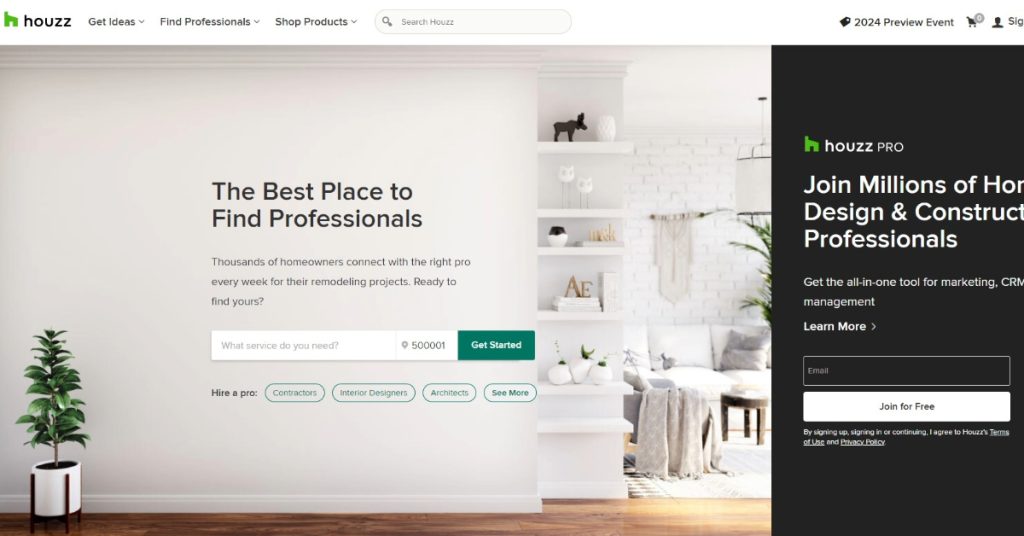
Houzz marketplace case study: book a demo to start yours
Houzz is a well-liked online hub and social network for individuals passionate about renovating homes and interior design, providing a wide range of inspiration, products, and services. If you’d like to start your own marketplace like Houzz, you’re facing a buy vs build decision. So before you decide to build it in-house on top of Spree open-source, consider using the feature-rich Enterprise Edition cutting your time-to-market to a few weeks.
Build vs Buy a marketplace?
Open-source has its share of advantages, like total ownership and the freedom to customize. Yet, these perks often involve considerable costs. Developing a complete marketplace solution is a time-consuming and expensive task, usually taking months or years, as we have learned from multiple marketplace projects.
If speed and reliability are your priorities, choosing a pre-built, enterprise-ready solution like Spree Commerce Enterprise Edition is the practical path forward—backed by the experience of those who know how unpredictable and risky custom marketplace development can be.
Back to the Houzz marketplace case study
Houzz, an online marketplace and community for home remodeling, interior design, and home improvement, has made a significant impact in its industry since its inception in 2009 by Adi Tatarko and Alon Cohen.
This platform allows users to explore millions of photos for inspiration, connect with professionals, read articles on home improvement, and shop for home furnishings and decor. Over the years, Houzz has evolved into a digital giant, reaching millions of users worldwide, and has expanded its offerings to include a comprehensive collection of resources and a mobile app for easy access.
Key features that have contributed to Houzz’s success include its user-friendly interface, extensive photo library for inspiration, easy connections with local professionals, active community engagement, and integrated e-commerce for a seamless shopping experience.
Looking at the recent data from 2023, more than half of the residential construction and design companies surveyed anticipate a positive outlook for the year, with interior designers being particularly optimistic. Most industry groups expect an increase in demand for their services, especially specialty decorators and interior designers.
However, slower revenue growth is projected across all industry sectors compared to the previous year, with decorating specialists expecting the highest growth at 6.1%, while architects anticipate the lowest at 0.3%. Additionally, the cost of doing business continues to rise, with a majority of firms reporting an increase in costs, primarily driven by product and material expenses.
This case study of Houzz highlights its growth from a small project to a leading online hub in the home improvement and design industry, marked by continuous innovation and adaptation to user needs and market trends.
How to emulate Houzz marketplace success?
To replicate Houzz’s success, you should consider debuting your marketplace rapidly, within weeks rather than months. Evaluate how your products fit with your audience’s requirements, and fine-tune your methods of gaining customers based on real-world data.
First, test the market before investing in its full-scale development.
Here’s how to get started:
- Book a marketplace demo call: We’ll help you evaluate Spree for your marketplace needs and get started with the Enterprise Edition
- Customize your Storefront: Use the drag & drop page builder or custom CSS
- Onboard Brands: Invite your brands or choose brands from our catalog
- Select Products: Curate products and collections manually or automate it
- Embed products: Make your content, newsletters, social media shoppable
- Get Paid: Get paid as soon as products are shipped by the brands
- End-to-end automation: brands sync, fulfillment, payouts, invoicing, taxes
When you’ve tried all that and it works, start thinking about building your own, custom-made marketplace project based on Spree Commerce. First, by decoupling the storefront and going headless with marketplace API, and later with your own backend, if you decide you really need it. Just lift and shift the storefront.
Nobody has to know what’s under the hood, right?



